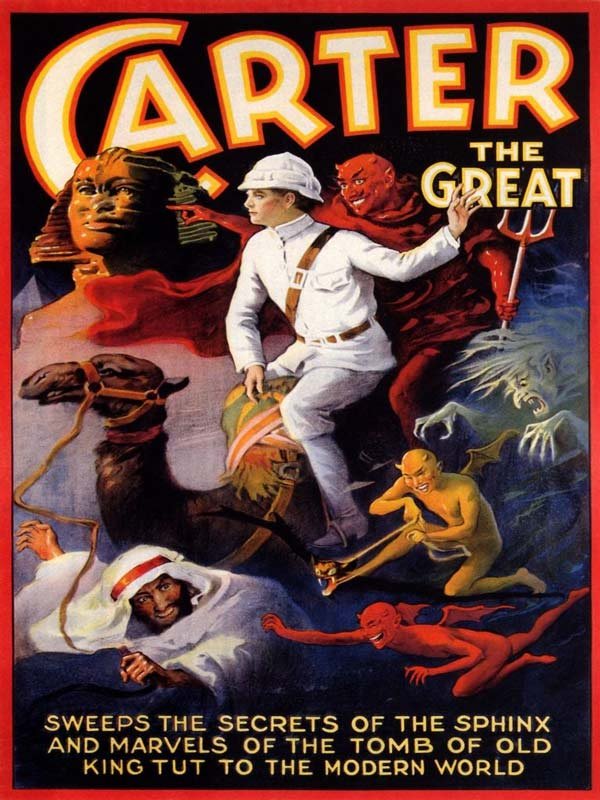People often ask about the magical memorabilia that adorn the walls of the Marrakech Magic Theater. The walls can’t talk but here are some of the history and mysteries behind these works of art.
CARTER THE GREAT
You will notice many Carter the Great posters at the theater, starting with the huge one in our stairwell. Charles Joseph Carter grew up in the San Francisco bay area with a fascination for magic at a very young age. When he was just ten years old, he performed tricks for live audiences as "Master Charles Carter the Original Boy Magician."
There were many American magic acts at the turn of the century, considered by many to be the "Golden Age of Magic," so Carter took his career abroad where he achieved his greatest fame and a certain international mystique. Like many performers, you have to go somewhere else to become famous. He began as a solo performer on a medicine show and evolved into a globetrotting illusionist. Some of his more popular illusions were "sawing a woman in half" – aided by assistants dressed in nurses uniforms to add to the "danger element" – and making a live elephant disappear while suspended in the air. His most popular illusion (and the one in our stairwell) was "Cheating the Gallows", in which a shrouded Carter would vanish just as he dropped at the end of a hangman's noose.
In 1917, in his early 40s, Carter was unable to continue his world touring magic show, and very wealthy from decades of traveling, purchased the famous Martinka Magic Palace in New York City. The prop table Jay uses in the show is a Martinka Table. The Martinka brothers built props and sets for all the famous illusionists in their workshop in the back part of the store. For decades, the Martinka Company continued doing so, they even creating illusions for the MGM classic "The Wizard of Oz." Remember when the wicked witch disappeared in a cloud of red smoke? Carter kept his pet lion, Monty, in the back room. Monty's roar would send a customer running for the front door more than once. Despite plans of opening Martinka shops all over the country, Carter soon discovered that he was losing money in the magic shop business and sold the Martinka two years later to a group of investors that included Harry Houdini.
Carter's true home was always in San Francisco, where he purchased a sprawling house in the Seacliff District near the Pacific Ocean. He would perform for small groups in the house's basement, and there are still occult references in the stained glass windows. Although sometimes mistakenly referred to as the "Houdini Mansion." In the 1980s–90s the house was rented by the Sumitomo Bank of California as the residence for the Bank's President. It later became a foreign consulate.
Carter's theatrical advertising lithographs helped draw hundreds of thousands of theater patrons to his shows. We feel his poster art was better than any other magician ever. Not intended to last very long, they were printed on thin paper by Otis Litho Co in Ohio. Carter's advertising prints are considered by most collectors of "the Golden Age of Magic" memorabilia to be highly desirable because they are particularly colorful and lush. One classic Carter window card is titled "Carter Beats the Devil," showing the magician playing poker with the devil (Carter holds four aces to the devil's quartet of kings). This poster can be seen as the cover art for the fictionalized book with the same title; Carter Beats The Devil. A historical mystery thriller novel by Glen David Gold.
In 1921, he lost a fortune while filming The Lion’s Bride in South Africa, a movie starring himself, that he had also written, produced, directed.[6] The film never made it to screen.
The Great Carter returned to touring, playing packed houses in Australia in 1924 and again in 1934.
In 1936, Charles Joseph Carter suffered a heart attack on his way to Bombay, India. He was sent to the hospital and his son Larry took over the show.








